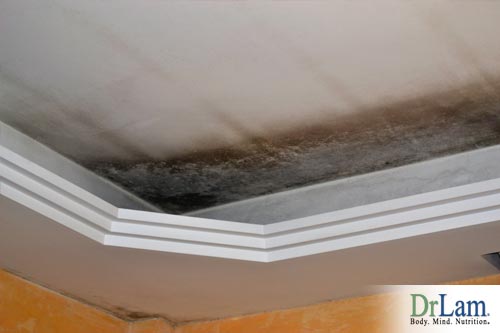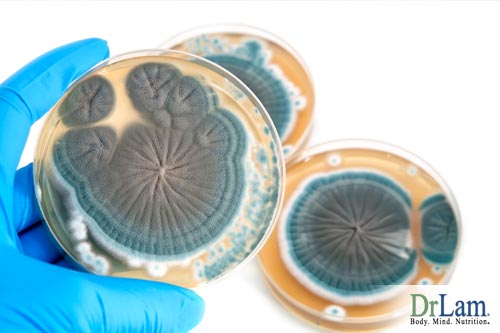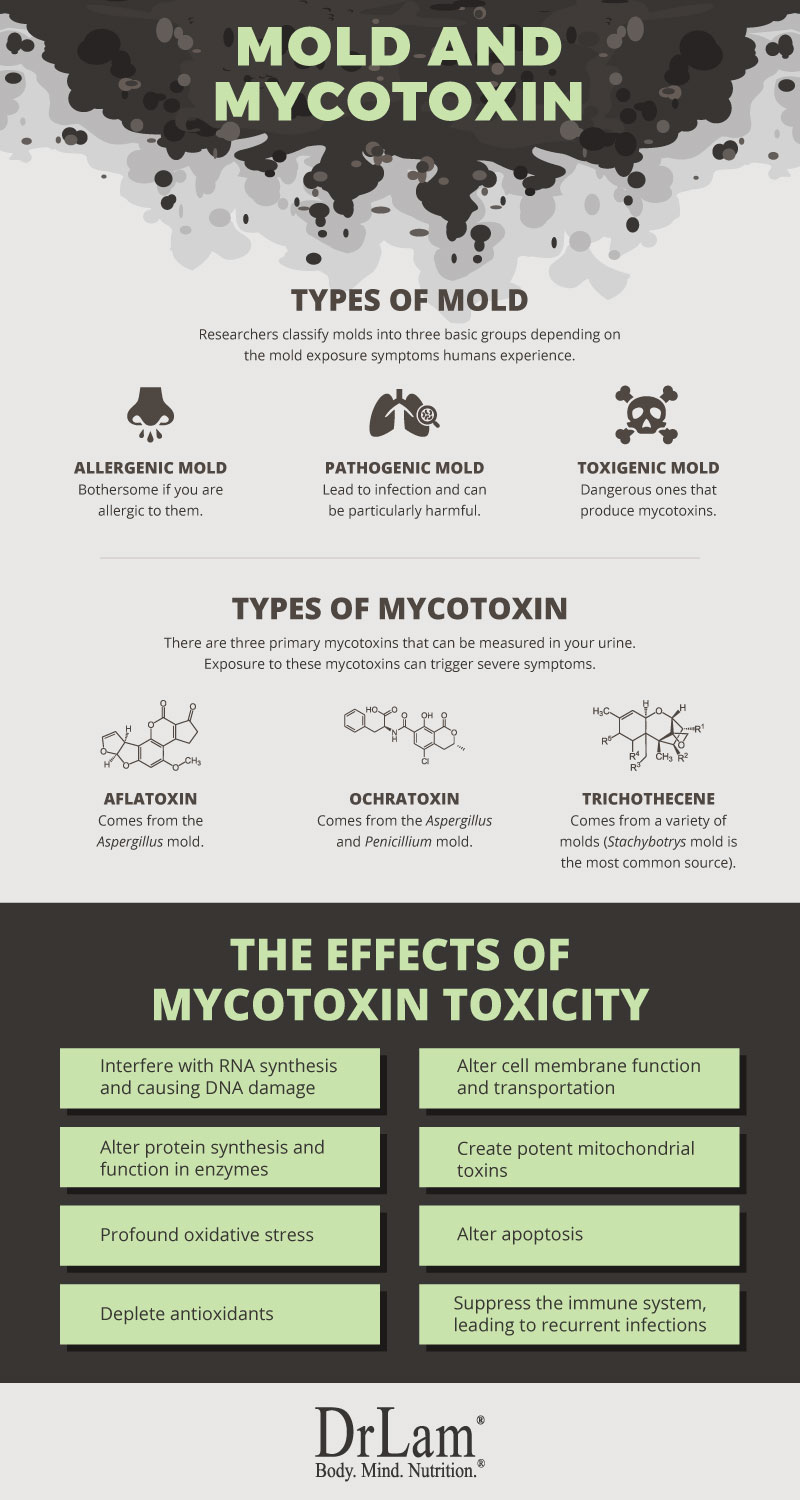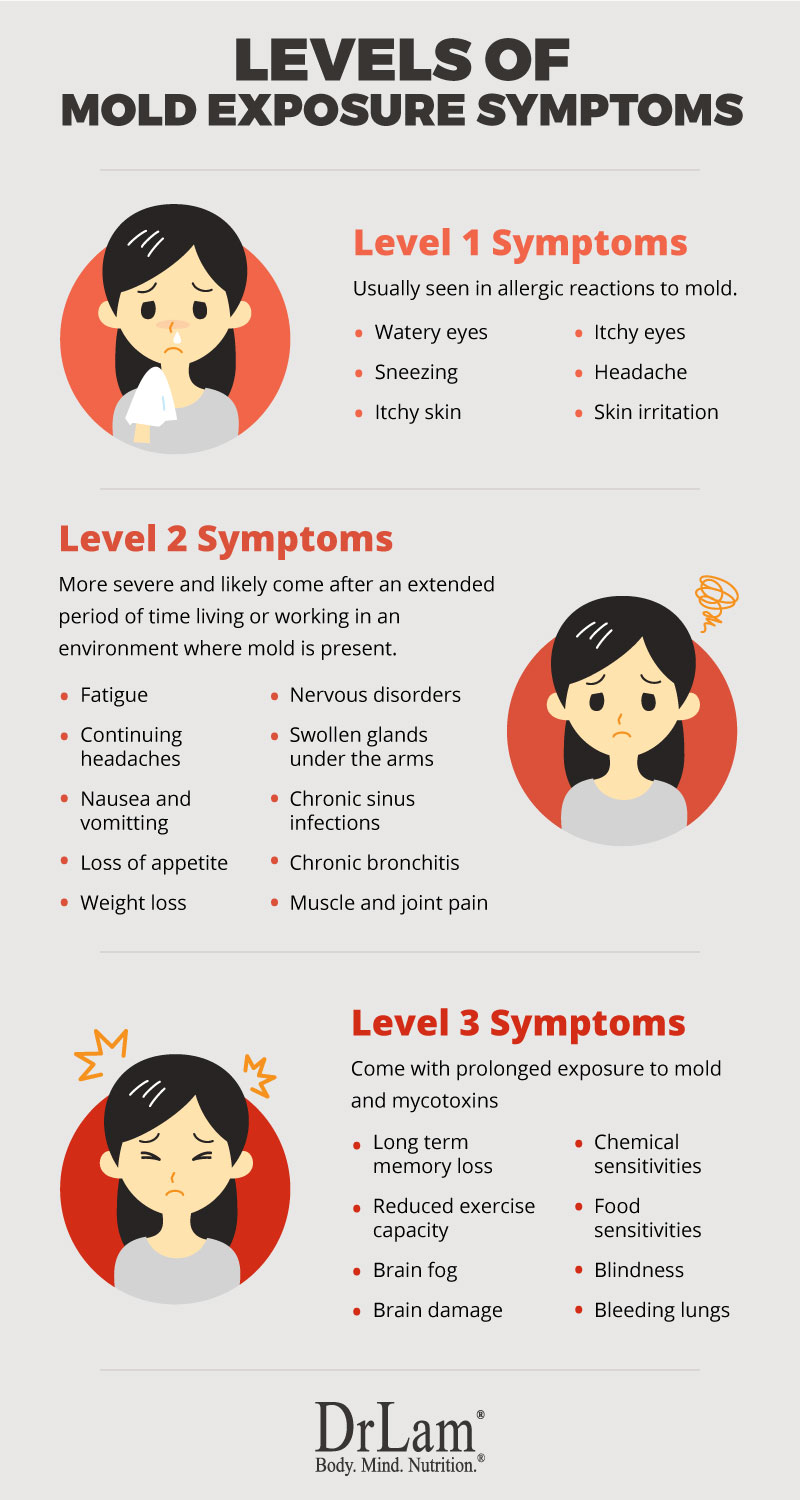 Researchers estimate up to 50% of illnesses may be connected to indoor air pollution, and a large proportion of this indoor pollution can be traced back to mold. Much of this mold grows in buildings that have been water damaged at some time in the past. Mold that is left to grow in places such as homes and businesses causes mold exposure symptoms in the people living and working there.
Researchers estimate up to 50% of illnesses may be connected to indoor air pollution, and a large proportion of this indoor pollution can be traced back to mold. Much of this mold grows in buildings that have been water damaged at some time in the past. Mold that is left to grow in places such as homes and businesses causes mold exposure symptoms in the people living and working there.
Mold grows well in areas where water has intruded on buildings, getting into the ceilings, walls, and insulation. This kind of water intrusion may be due to high humidity, as well as leaks. One of the best place for mold to grow is in cellulose. Cellulose is used in most areas of nearly all buildings, including houses. As long as the moisture remains in these areas, mold will continue to grow. The growth of mold leads to the production of more and more spores and secondary metabolites like mycotoxins.
Spores are the way mold reproduces. The mold itself and the spores are not necessarily hazardous, unless a person is allergic to them. However, mycotoxins on the surface of or within spores can be very dangerous, causing significant mold exposure symptoms.
When you inhale, touch, or ingest mold spores containing mycotoxins, they can lead to very serious illnesses. Toxins of this kind are very potent and can attack every organ of the body. There is some evidence they can survive for many years in areas of the body. They may lead to serious symptoms for a very long time afterward.
There may be anywhere from one and a half to five million species of mold. These include yeast, mold, and mushrooms. All of them are fungi that obtain their nutrients through enzymes that break down decaying organic matter. Some researchers believe the mycotoxins some of these molds produce may be their way of destroying competing species for food sources.
Researchers classify molds into three basic groups depending on the mold exposure symptoms humans experience:
Allergenic mold exposure symptoms usually only are bothersome if you are allergic to them. They seldom produce life-threatening effects. Children seem to be most sensitive to these types of molds. At times, determining what is causing your symptoms can be problematic.
Pathogenic mold exposure symptoms lead to some kind of infection. This can be particularly harmful if you have a compromised immune system already. A type of pneumonia called hypersensitivity pneumonitis can be triggered by this group of molds.
Toxigenic mold exposure symptoms are the dangerous ones that produce mycotoxins. Serious health effects like immunosuppression and even cancer are possible. The mycotoxins grow on the surface of spores for these molds.
 There are several common types of mold that grow in homes.
There are several common types of mold that grow in homes.
Cladosporium is an outdoor fungus that can be brought into your home in a number of ways. Inside, it grows on textiles, wood, and any material that is damp and porous. Often, it triggers Mold exposure symptoms such as hay fever and asthma.
Penicillium is very commonly found growing on wallpaper, decaying fabrics, carpet, and fiberglass duct insulation. It’s mold exposure symptoms can cause allergies and asthma. One of the mycotoxins it develops is penicillin.
Alternaria is commonly found in your nose, mouth, and upper respiratory system. It does bring on allergic responses.
Aspergillus is usually found in climates that stay warm and humid. It is commonly found on house dust. It’s mold exposure symptoms can lead to lung infections.
Stachybotrys chartarum, more commonly known as “black mold” is less common, but can be found in your home. This dangerous mold grows on material that has a high cellulose content, like wood, fiberboard, even dust and lint. Once this mold is growing in your home, it can be easily spread through your house by the air handling system that distributes cool and warm air.
Once any of the spores are spread and find a place that is moist, the mold begins to grow. When it grows, the chances of mycotoxins developing increases, and the likelihood of you developing mold toxicity symptoms due to exposure increases as well.
There are three primary mycotoxins that can be measured in your urine. Exposure to these mycotoxins can trigger severe symptoms. These mycotoxins are aflatoxin, ochratoxin, and macrocyclic trichothecene. The first two primarily come from the aspergillus mold. Ochratoxin also comes from penicillium. The trichothecene mycotoxin comes from a variety of molds, but the stachybotrys mold is the most common source in homes. This mycotoxin is so deadly that it has been used in chemical warfare agents.

Mycotoxins have a number of negative effects on the human body. Some mycotoxins are more detrimental to your health than heavy metals when concentration is a factor.
Part of the reason for this is that mycotoxins affect more systems in the body than do heavy metals or pesticides. Spreading the toxic effect around your body makes you sicker. This ability to affect so much of the body also has to do with the rapid mutation possible in fungi. This allows them to negotiate around the immune system, while suppressing the immune system at the same time.
Another reason for greater toxicity, especially in the case of inhaled the mold spores, is the lack of a barrier between the olfactory neurons and your brain. This allows the mycotoxins direct access to the brain. The same thing can happen if mold spores containing mycotoxins get in the eyes. This allows serious brain complications to develop if mold exposure symptoms go unaddressed.
 Mold infections occur sub-clinically most of the time, making detection very difficult. Laboratory tests are not very sensitive or accurate, and many mold driven illnesses are overlooked. In addition, chronic minute amounts of toxin secreted constantly by mold pathogens lead to reactive metabolite overload. The body is flooded by a sea of toxins that is annoying at best and can be incapacitating at worst.
Mold infections occur sub-clinically most of the time, making detection very difficult. Laboratory tests are not very sensitive or accurate, and many mold driven illnesses are overlooked. In addition, chronic minute amounts of toxin secreted constantly by mold pathogens lead to reactive metabolite overload. The body is flooded by a sea of toxins that is annoying at best and can be incapacitating at worst.
The effects of mycotoxin toxicity include:
People react differently to exposure to mold, leading to many symptoms. Depending on the method of entry into the human body, symptoms of mold exposure can vary greatly.
Mold can enter the body from eating or smoking products with mold on or in them. If you work or live in a building where mold grows, it can come from breathing in mold spores harboring mycotoxins. Mold can also enter the body if you handle something with mold spores on it. When you rub your eyes or touch another part of your body, especially a part with a mucosal membrane, mold spores are transferred to that body part.
Some research suggests mold spores can remain in your nasal cavities for a long time. This leads to misdiagnosis of some sinusitis illnesses. Common remedies for this kind of sinus infection do nothing to rid you of mold spores. In fact, they may even increase the spore population.
Mold also causes allergic reactions. When you’re exposed to mold, it enters your body as a foreign material, prompting it to develop antibodies to fight the invader. These antibodies are what bring on allergic symptoms.
After exposure, your body continues making antibodies that remember these substances. Any re-exposure triggers your body to release histamines to fight the invasion. This brings on the allergy symptoms everybody knows about.
As with most illnesses, there are certain risk factors that play a part in how many symptoms you’ll experience after exposure to mold.
Family history. If you have a history in your family of developing allergic reactions, you’ll be more likely to develop allergies to mold.
Occupational factors. Working in jobs that expose you to mold frequently or on a long-term basis makes it more likely for you to develop allergies to mold exposure.
Humid living conditions. If you live in an area of the country where humidity levels are frequently high, you’re more likely to be sensitive to mold exposure and mold exposure symptoms.
Buildings with high moisture levels. Living or working in buildings that are continually damp or have lots of moisture will lead to more mold growth, increased exposure to mold, and a greater likelihood of allergic reactions.
Poorly ventilated houses. Houses with poor ventilation can seal in moisture, leading to mold growth. Bathrooms are really good locations for mold to grow.
 There appear to be three levels of symptoms from exposure to mold. These levels distinguish the severity of symptoms.
There appear to be three levels of symptoms from exposure to mold. These levels distinguish the severity of symptoms.
Level 1 symptoms are those usually seen in allergic reactions to mold:
Level 2 symptoms are more severe and likely come after an extended period of time living or working in an environment where mold is present. This exposure to mold may have been on an off and on basis. These mold exposure symptoms include:
While there appear to be a lot of symptoms listed, it’s important to keep in mind with the large number of mold varieties, every one of them may bring on a different set of mold exposure symptoms.

Level 3 symptoms are those that come with prolonged exposure to mold and mycotoxins:
© Copyright 2017 Michael Lam, M.D. All Rights Reserved.

